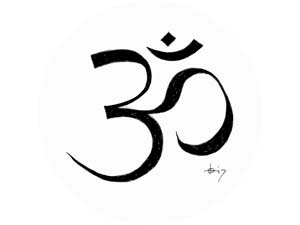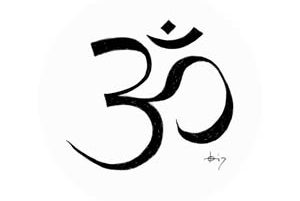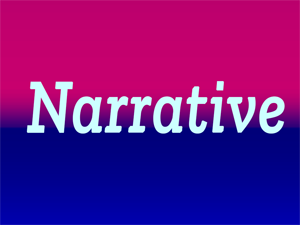Nivedita Yohana
Vritra is a Vedic serpent or dragon in Hinduism, the personification of drought and adversary of Indra (king of the highest heaven).
Vritra is identified as an Asura[1]. Vritra is also known in the Vedas as Ahi (“snake”).
Vritra appears as a dragon blocking the course of the rivers and is heroically slain by Indra.
According to the Rig Veda, Vritra kept the waters of the world captive until he was killed by Indra, who destroyed all the ninety-nine fortresses of Vritra before liberating the imprisoned rivers.
The myth in the Rig Veda (in simple English) is as follows
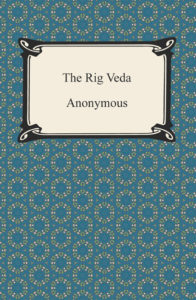 According to the Rig Veda, Vritra imprisoned the waters of the world captive until he was killed by Indra, who destroyed all the ninety-nine fortresses before liberating the imprisoned rivers.
According to the Rig Veda, Vritra imprisoned the waters of the world captive until he was killed by Indra, who destroyed all the ninety-nine fortresses before liberating the imprisoned rivers.
The combat began soon after Indra was born, and he had drunk a large volume of Soma at Tvashtri’s house to empower him before facing Vritra.
Tvashtri fashioned the thunderbolt (Vajrayudha) for Indra, and Vishnu, when asked to do so by Indra, made space for the battle by taking the three great strides for which he became famous.
Vritra broke Indra’s two jaws during the battle, but was then thrown down by the latter and, in falling, vanquished the fortresses that had already been shattered.
For this feat, Indra became known as Vritrahan “slayer of Vritra” and also as “slayer of the first-born of dragons”.
Vritra’s mother, Danu (who was also the mother of the Danava race of Asuras), was then attacked and defeated by Indra with his thunderbolt.
Introduction to the Vedas
Vedas are the earliest Hindu scriptures, written in early Sanskrit, containing hymns, philosophy, and guidance on ritual for the priests of Vedic religion.
Believed to have been directly revealed to seers among the early Aryans in India, and preserved by oral tradition, the four main collection are known as ‘Vedas’.
The Sanskrit word Vedas is derived from the Sanskrit word ‘vid’ which means ‘to know’, ‘to see’, ‘to intuited’. This is reconstructed as being derived from the proto-indo European root ‘ueid’ — meaning “see”, know.
The Vedas are therefore regarded as Shruti in Hinduism meaning “what is heard” as contrasted with other texts designated Smritis (“what is remembered”), accounts of great heroes and their struggles in works such as the Mahabharata, Ramayana, and Bhagavad Gita (although some sects of Hinduism regard the Bhagavad Gita as Shruti).
The Four Vedas
The texts which make up the Four Vedas are:
- Rig Veda
- Sama Veda
- Yajur Veda
- Atharva Veda
The Vedas are large body of texts originating in ancient India, composed in Vedic Sanskrit. Ancient Hindu Rishis (seers) considered the Vedas to be ‘Apaurusheya’ which means “not of a man, superman and” impersonal, but the exploration of whole universe, Vedas are authorless. The Vedas are not only ruminations of Vedic rishis but they had intuited the impersonal truth, the knowledge at their highest level of consciousness and soul.
The Rig Veda is the earliest of the four Vedas. The Sama Veda, Yajur Veda and Atharva Veda were compiled after the age of the Rig Veda and are ascribed to the Vedic period.
The Rig Veda
The most celebrated and well-known part of the Vedas is undoubtedly the Rigveda.
The Rigveda — Sanskrit Rig-Veda, a compound of individual strophes called ṛc (ric), meaning “a sacred verse recited in praise of deity” and Veda means knowledge.
Thus, we can understand the direct meaning of Rigveda to be “The knowledge of sacred recitation”.
The Rig Veda is a collection of inspired songs or hymns and is a main source of information on the Rig Vedic civilization.
It is the oldest book in any Indo-European language and contains the earliest form of all Sanskrit mantras, dating back to 1500-1000 BCE. Some scholars date the Rig Veda as early as 12000-4000 BCE. The Rigveda was preserved orally before it was written down about 300 BCE.
The Rig-Vedic ‘samhita’
The Rig-Vedic ‘samhita’ or collection of mantras consists of 1,017 hymns or ‘sūktas’, covering about 10,600 stanzas, divided into eight ‘astakas,’ each having eight ‘adhayayas’ or chapters, which are sub-divided into various groups.
The hymns are the work of many authors, or seers, called ‘rishis.’ There are seven primary seers identified: Atri, Kanwa, Vashistha, Vishwamitra, Jamadagni, Gotama and Bharadwaja.
An early stage of Vedic religion
The Rig Veda accounts comprehensively the social, religious, political and economic background of the Rig-Vedic civilization.
Even though monotheism characterizes some of the hymns of Rig Veda, naturalistic polytheism and monism can be discerned in the religion of the hymns of the Rig Veda.
The Rigveda is far more ancient than any other Indo-Aryan text. For this reason, it was at the centre of attention of western scholarship from the times of Max-Muller and Rudolf Roth onwards. The Rigveda record an early stage of Vedic religion.
The manuscripts were written in Brahmi script on materials made from birch bark or palm leaves, which decompose fairly quickly in the topical climate and therefore, were routinely copied over the generations to help preserve the text until the advent of the printing press from the 16th century.
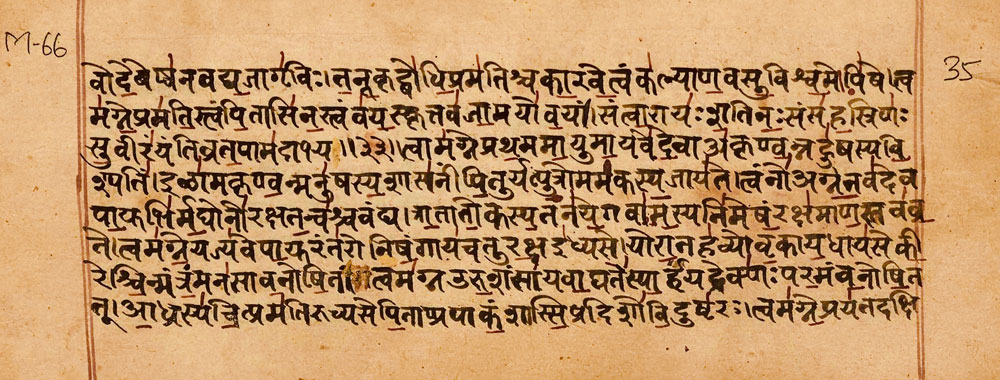
Philosophical reflection
This philosophical reflection characterizes the essence of Hinduism in that the point of personal existence is to question it as one moves from the basic needs of life toward self-actualization and union with the Divine.
The Rig Veda encourages these kinds of questions through hymns to various gods — Agni, Mitra, Varuna, Indra, and Soma notably — who would eventually be seen as avatars of the Supreme Over Soul, First Cause, and source of existence, Brahman.
The myth in Rig Veda Book 4 Hymn 18
Sanskrit version
अयम पन्था अनुवित्तः पुराणो यतो देवा उदजायन्त विश्वे |
अतश चिद आ जनिषीष्ट परव्र्द्धो मा मातरम अमुया पत्तवे कः ||
नाहम अतो निर अया दुर्गहैतत तिरश्चता पार्श्वान निर गमाणि |
बहूनि मे अक्र्ता कर्त्वानि युध्यै तवेन सं तवेन पर्छै ||
परायतीम मातरम अन्व अचष्ट न नानु गान्य अनु नू गमानि |
तवष्टुर गर्हे अपिबत सोमम इन्द्रः शतधन्यं चम्वोः सुतस्य ||
किं स रधक कर्णवद यं सहस्रम मासो जभार शरदश च पूर्वीः |
नही नव अस्य परतिमानम अस्त्य अन्तर जातेषूत ये जनित्वाः ||
अवद्यम इव मन्यमाना गुहाकर इन्द्रम माता वीर्येणा नयॄष्टम |
अथोद अस्थात सवयम अत्कं वसान आ रोदसी अप्र्णाज जायमानः ||
एता अर्षन्त्य अललाभवन्तीर रतावरीर इव संक्रोशमानाः |
एता वि पर्छ किम इदम भनन्ति कम आपो अद्रिम परिधिं रुजन्ति ||
किम उ षविद अस्मै निविदो भनन्तेन्द्रस्यावद्यं दिधिषन्त आपः |
ममैतान पुत्रो महता वधेन वर्त्रं जघन्वां अस्र्जद वि सिन्धून ||
ममच चन तवा युवतिः परास ममच चन तवा कुषवा जगार |
ममच चिद आपः शिशवे मम्र्ड्युर ममच चिद इन्द्रः सहसोद अतिष्ठत ||
ममच चन ते मघवन वयंसो निविविध्वां अप हनू जघान |
अधा निविद्ध उत्तरो बभूवाञ छिरो दासस्य सम पिणक वधेन ||
गर्ष्टिः ससूव सथविरं तवागाम अनाध्र्ष्यं वर्षभं तुम्रम इन्द्रम |
अरीळ्हं वत्सं चरथाय माता सवयं गातुं तन्व इछमानम ||
उत माता महिषम अन्व अवेनद अमी तवा जहति पुत्र देवाः |
अथाब्रवीद वर्त्रम इन्द्रो हनिष्यन सखे विष्णो वितरं वि करमस्व ||
कस ते मातरं विधवाम अचक्रच छयुं कस तवाम अजिघांसच चरन्तम |
कस ते देवो अधि मार्डीक आसीद यत पराक्षिणाः पितरम पादग्र्ह्य ||
अवर्त्या शुन आन्त्राणि पेचे न देवेषु विविदे मर्डितारम |
अपश्यं जायाम अमहीयमानाम अधा मे शयेनो मध्व आ जभार ||
Transcription
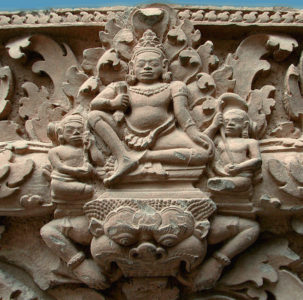
ayam panthā anuvittaḥ purāṇo yato devā udajāyanta viśve |
ataś cid ā janiṣīṣṭa pravṛddho mā mātaram amuyā pattave kaḥ ||
nāham ato nir ayā durghahaitat tiraścatā pārśvān nir ghamāṇi |
bahūni me akṛtā kartvāni yudhyai tvena saṃ tvena pṛchai ||
parāyatīm mātaram anv acaṣṭa na nānu ghāny anu nū ghamāni |
tvaṣṭur ghṛhe apibat somam indraḥ śatadhanyaṃ camvoḥ sutasya ||
kiṃ sa ṛdhak kṛṇavad yaṃ sahasram māso jabhāra śaradaś ca pūrvīḥ |
nahī nv asya pratimānam asty antar jāteṣūta ye janitvāḥ ||
avadyam iva manyamānā ghuhākar indram mātā vīryeṇā nyṝṣṭam |
athod asthāt svayam atkaṃ vasāna ā rodasī apṛṇāj jāyamānaḥ ||
etā arṣanty alalābhavantīr ṛtāvarīr iva saṃkrośamānāḥ |
etā vi pṛcha kim idam bhananti kam āpo adrim paridhiṃ rujanti ||
kim u ṣvid asmai nivido bhanantendrasyāvadyaṃ didhiṣanta āpaḥ |
mamaitān putro mahatā vadhena vṛtraṃ jaghanvāṃ asṛjad vi sindhūn ||
mamac cana tvā yuvatiḥ parāsa mamac cana tvā kuṣavā jaghāra |
mamac cid āpaḥ śiśave mamṛḍyur mamac cid indraḥ sahasod atiṣṭhat ||
mamac cana te maghavan vyaṃso nivividhvāṃ apa hanū jaghāna |
adhā nividdha uttaro babhūvāñ chiro dāsasya sam piṇak vadhena ||
ghṛṣṭiḥ sasūva sthaviraṃ tavāghām anādhṛṣyaṃ vṛṣabhaṃ tumram indram |
arīḷhaṃ vatsaṃ carathāya mātā svayaṃ ghātuṃ tanva ichamānam ||
uta mātā mahiṣam anv avenad amī tvā jahati putra devāḥ |
athābravīd vṛtram indro haniṣyan sakhe viṣṇo vitaraṃ vi kramasva ||
kas te mātaraṃ vidhavām acakrac chayuṃ kas tvām ajighāṃsac carantam |
kas te devo adhi mārḍīka āsīd yat prākṣiṇāḥ pitaram pādaghṛhya ||
avartyā śuna āntrāṇi pece na deveṣu vivide marḍitāram |
apaśyaṃ jāyām amahīyamānām adhā me śyeno madhv ā jabhāra ||
English Translation
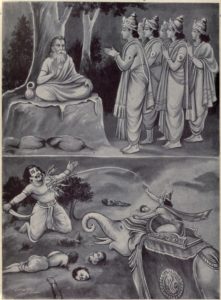
This is the ancient and accepted pathway by which all Gods have come into existence.
Hereby could one be born though waxen mighty. Let him not, otherwise, destroy his Mother.
Not this way go I forth: hard is the passage. Forth from the side obliquely will I issue.
Much that is yet undone must I accomplish; one must I combat and the other question.
He bent his eye upon the dying Mother: My word I now withdraw. That way I follow.
In Tvaṣṭar’s dwelling India drank the Soma, a hundredworth of juice pressed from the mortar.
What strange act shall he do, he whom his Mother bore for a thousand months and many autumns?
No peer hath he among those born already, nor among those who shall be born hereafter.
Deeming him a reproach, his mother hid him, Indra, endowed with all heroic valour.
Then up he sprang himself, assumed his vesture, and filled, as soon as born, the earth and heaven.
With lively motion onward flow these waters, the Holy Ones, shouting, as ‘twere, together.
Ask them to. tell thee what the floods are saying, what girdling rock the waters burst asunder.
Are they addressing him with words of welcome? Will the floods take on them the shame of Indra?
With his great thunderbolt my Son hath slaughtered Vṛtra, and set these rivers free to wander.
I cast thee from me, mine, — thy youthful mother: thee, mine own offspring, Kusava hath swallowed.
To him, mine infant, were the waters gracious. Indra, my Son, rose up in conquering vigour.
Thou art mine own, O Maghavan, whom Vyaṁsa struck to the ground and smote thy jaws in pieces.
But, smitten through, the mastery thou wonnest, and with thy bolt the Dāsa’s head thou crushedst.
The Heifer hath brought forth the Strong, the Mighty, the unconquerable Bull, the furious Indra.
The Mother left her unlicked Calf to wander, seeking himself, the path that he would follow.
Then to her mighty Child the Mother turned her, saying, My son, these Deities forsake thee.
Then Indra said, about to slaughter Vṛtra, O my friend Vṛtra, stride full boldly forward.
Who was he then who made thy Mother widow? Who sought to stay thee lying still or moving?
What God, when by the foot thy Sire thou tookest and slewest, was at hand to give thee comfort?
In deep distress I cooked a dog’s intestines. Among the Gods I found not one to comfort.
My consort I beheld in degradation. The Falcon then brought me the pleasant Soma.
- Anonymous (2013) HYMN XVIII. In The Rig Veda. Translated by Griffith, R.T. Digireads.com Publishing
- Koller, J.M. (2011). Asian philosophies. Upper Saddle River, NJ: Pearson Education.
- Sarasvati, B. (1997). Anthology of Vedic hymns: Being a collection of hymns from the four Vedas. Sahibabad, Ghaziabad: Kusum Lat Arya Pratishthan.
- The Rigveda. (2014). Oxford: Oxford University Press.
- Trikha, J.K. (n.d.). Rig Veda: A scientific and intellectual analysis of the hymns. Bombay: Bharatiya Vidya Bhavan.
Notes
[1] Asuras are described in Indian texts as powerful superhuman demigods with good or bad qualities.
[2] Source: Rigveda manuscript page (1500-1200 BCE) sample iii, Sanskrit, Devanagari – photo Ms Sarah Welch
[3] Source: Indra subduing Vritra – Vritra and Vala, Part Three, Feature stories by Sun Staff
[4] Source: Story of Vritra – Indra and other gods request Sage Dachichi to grant his backbone to make the vajra, Top: Indra and other gods request Sage Dachichi to grant his backbone to make the vajra. Bottom: Indra kills Vritra by the vajra Illustration of Hindi Gita Press Mahabharata, Toronto Public Library

